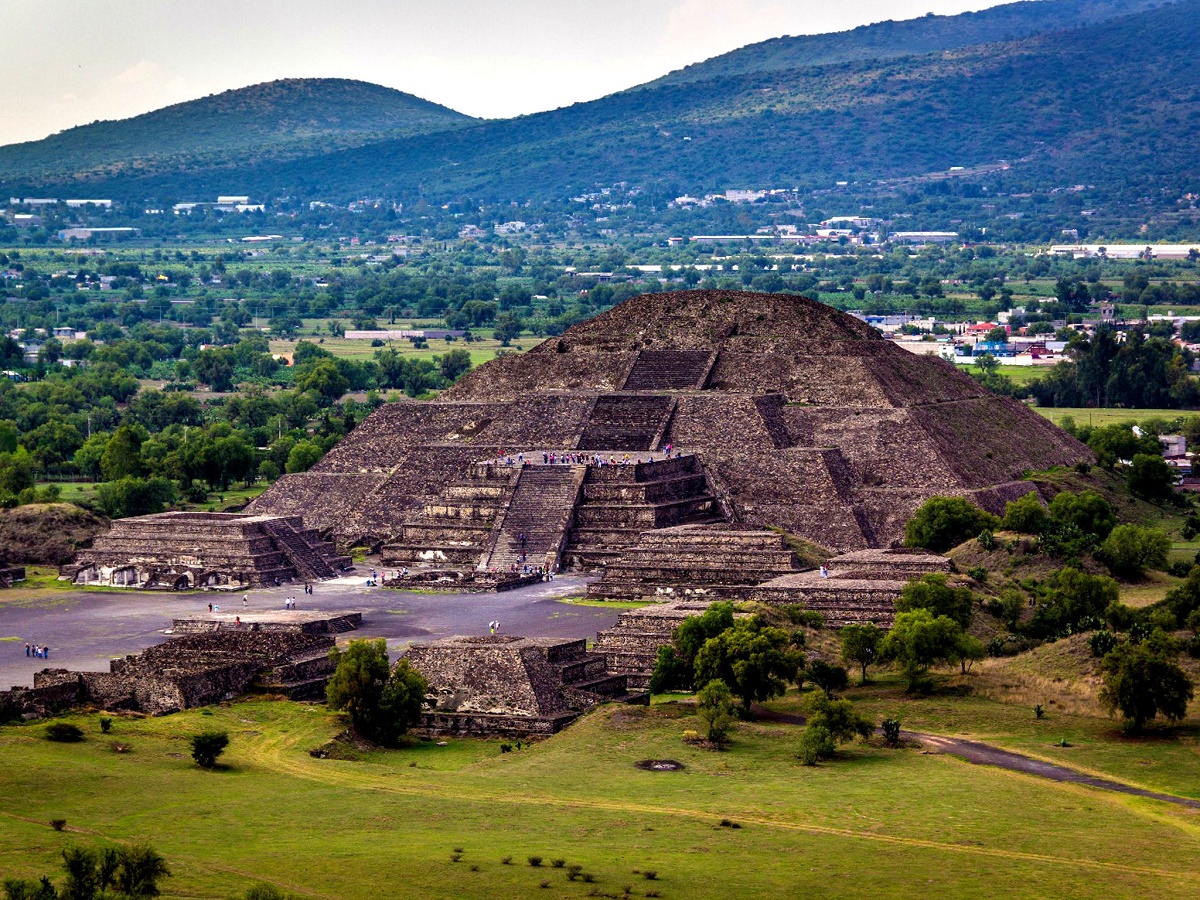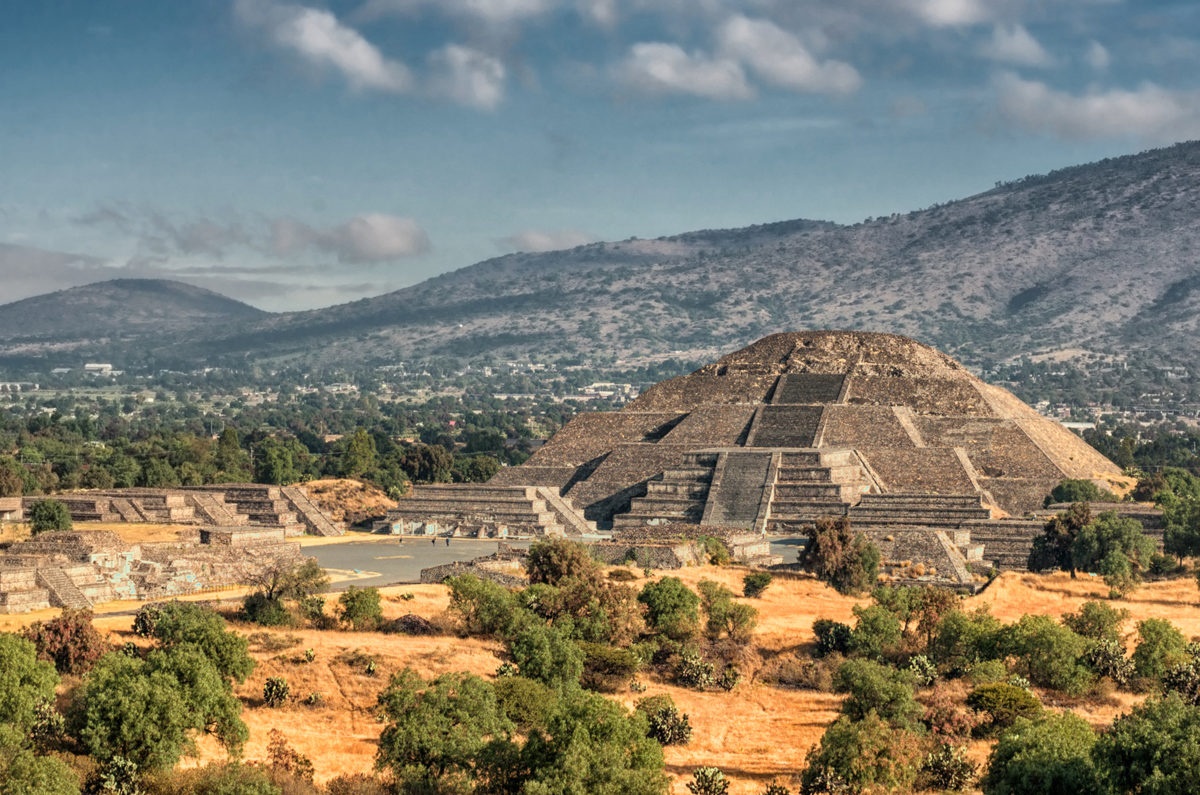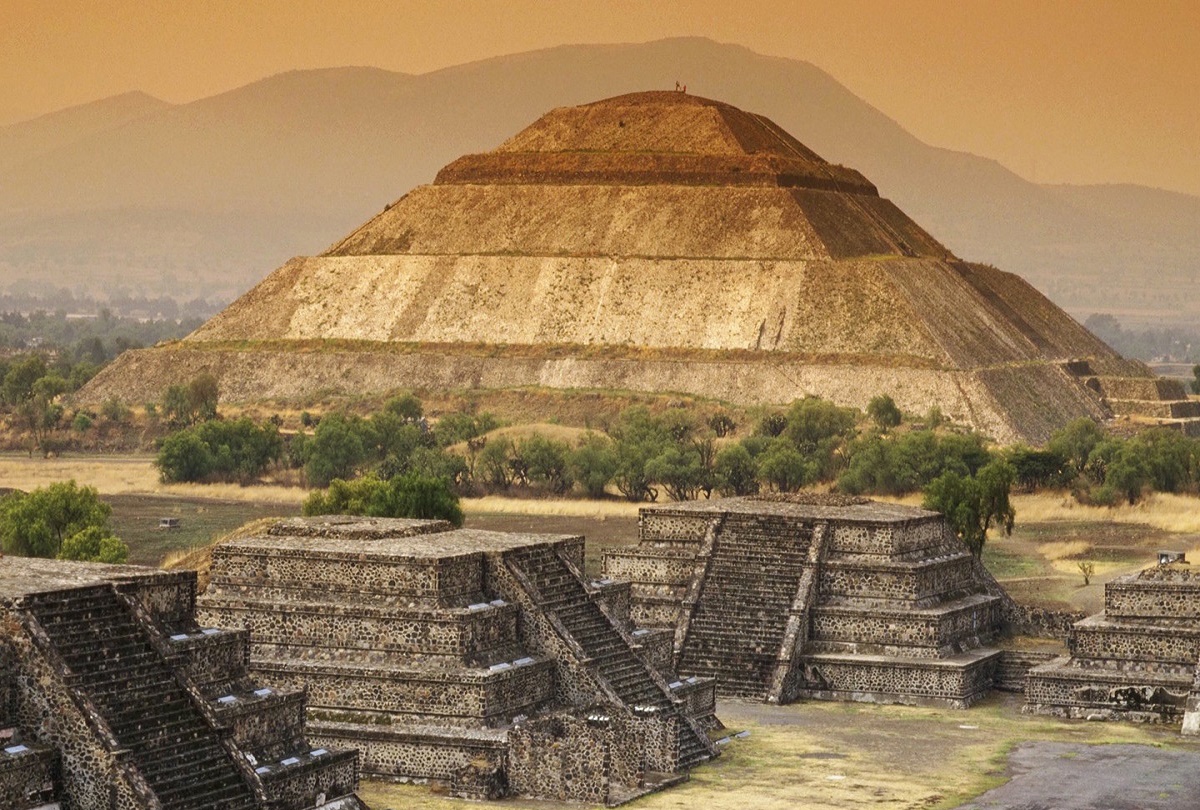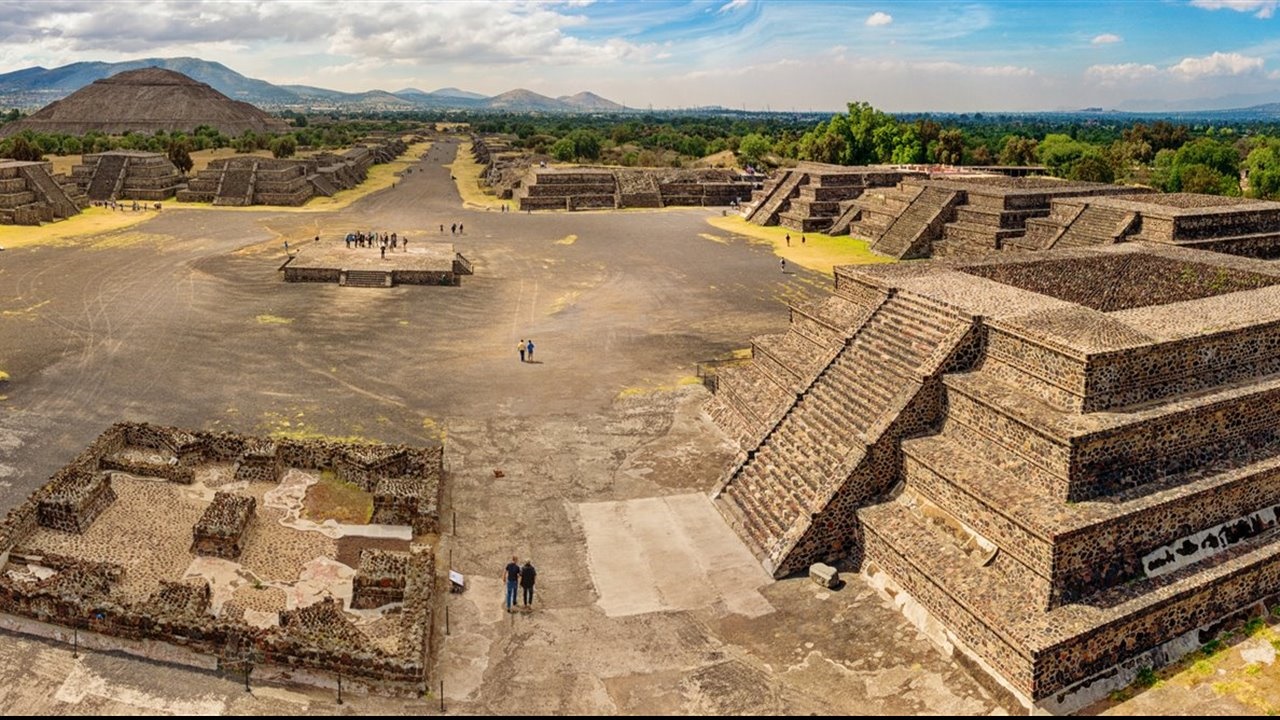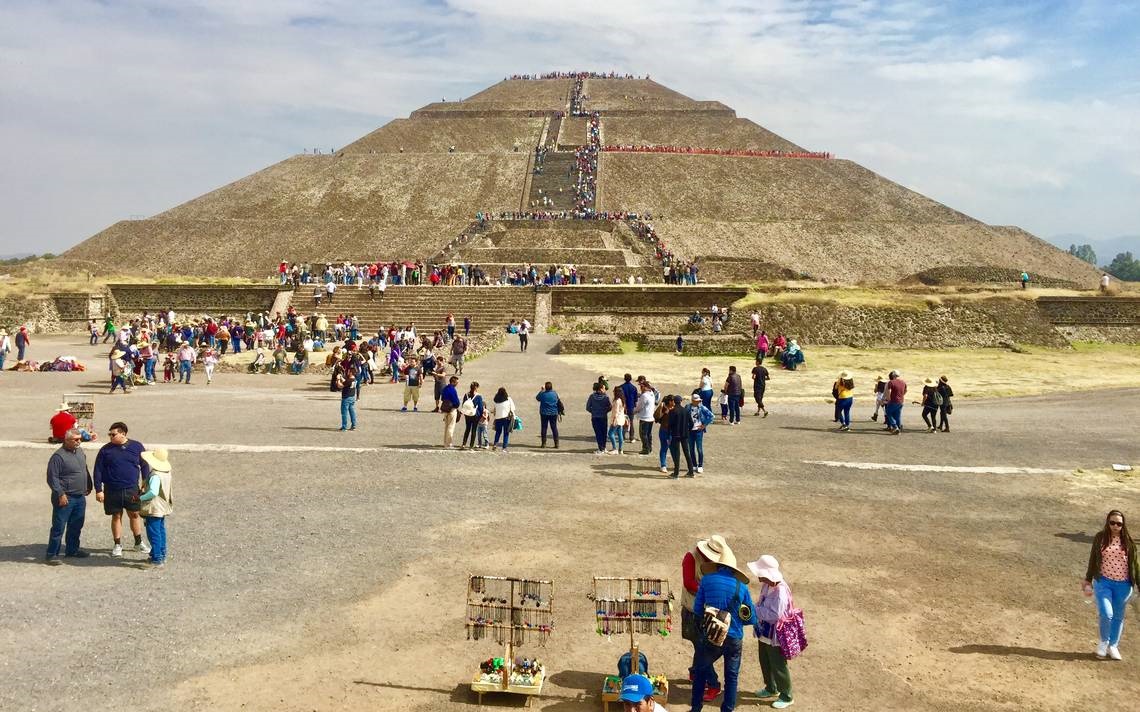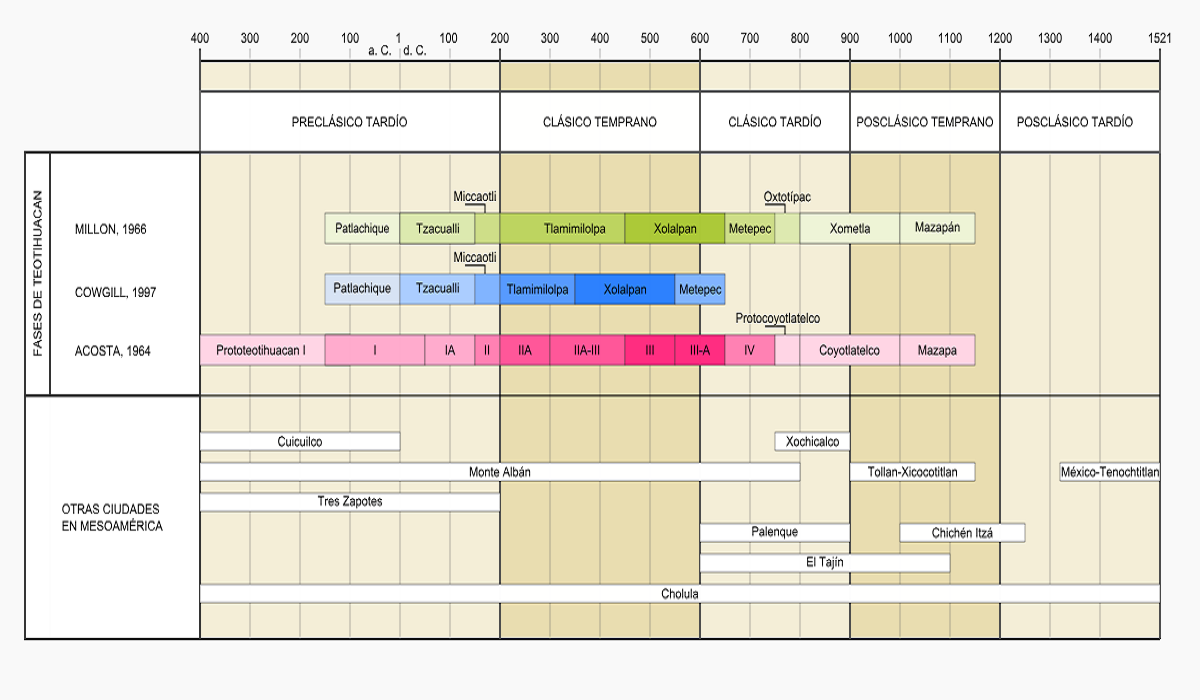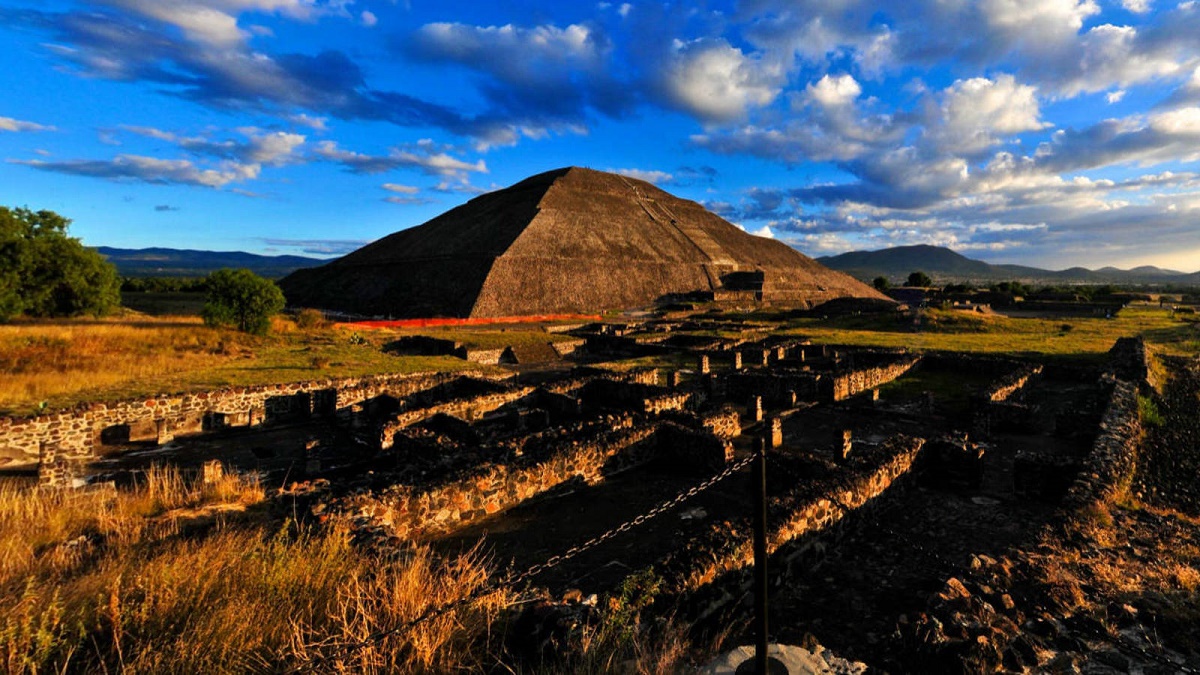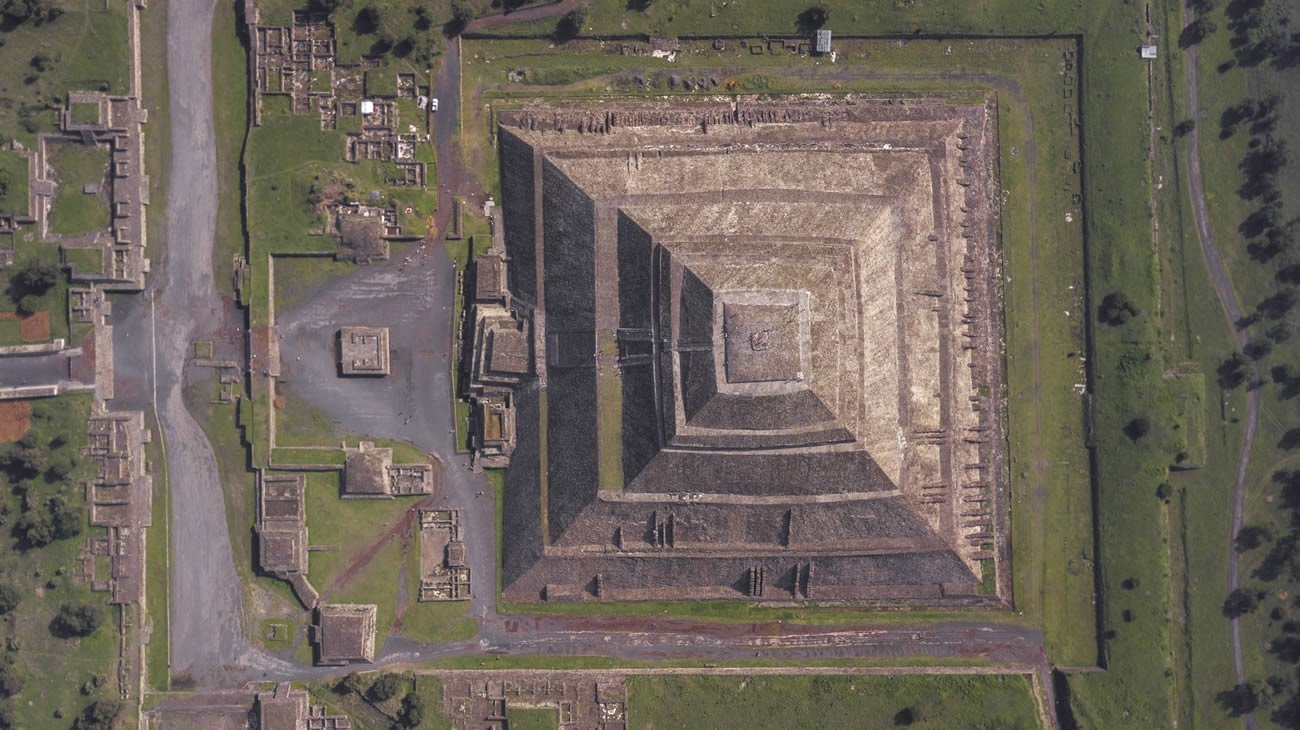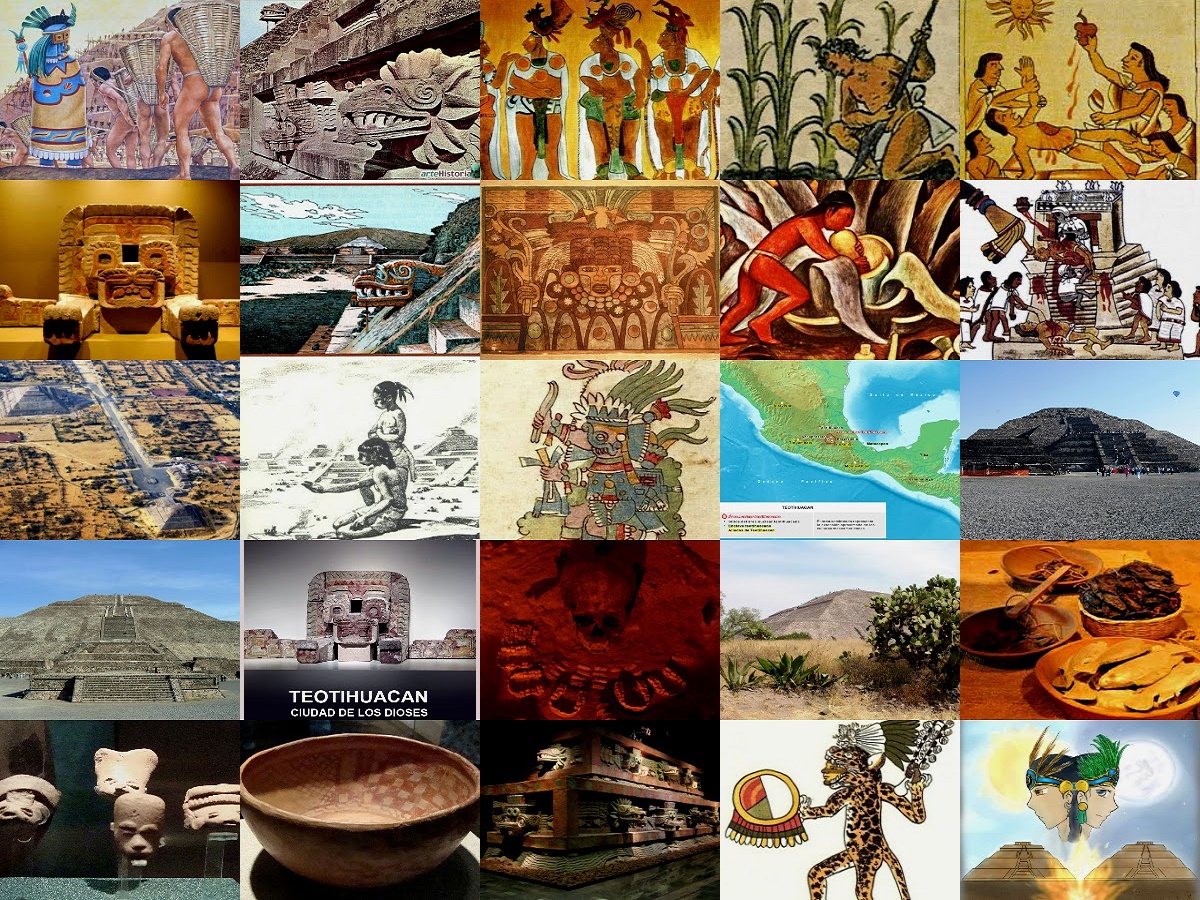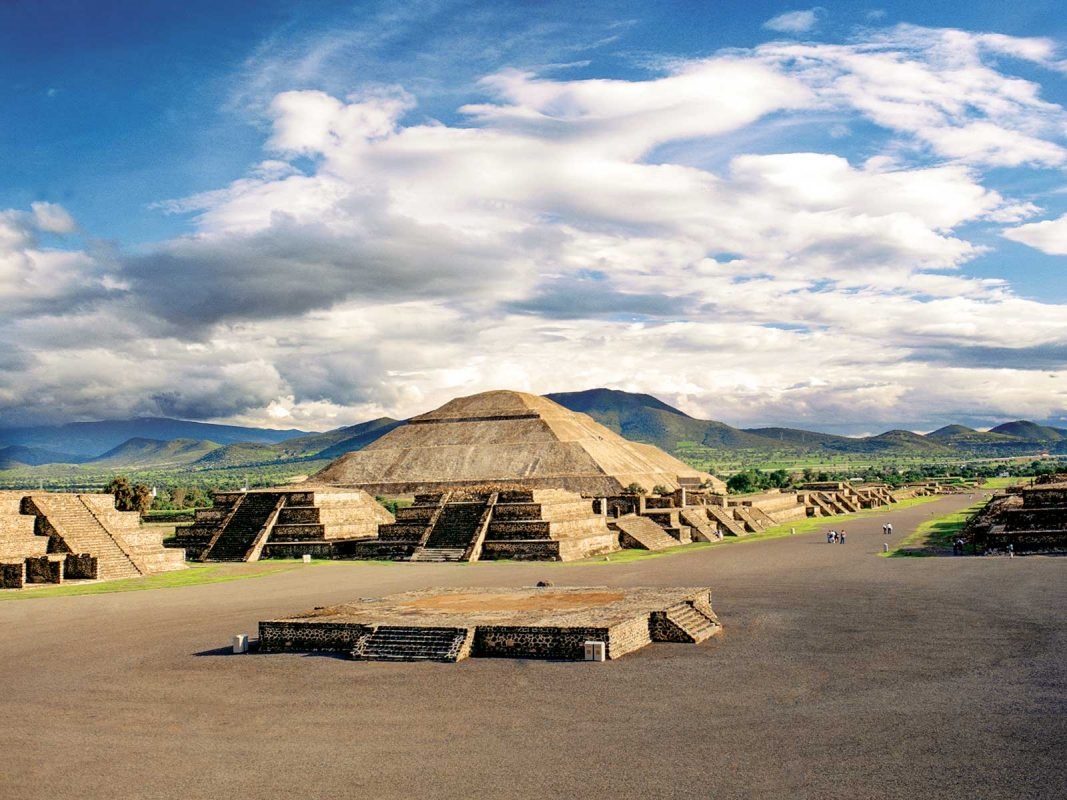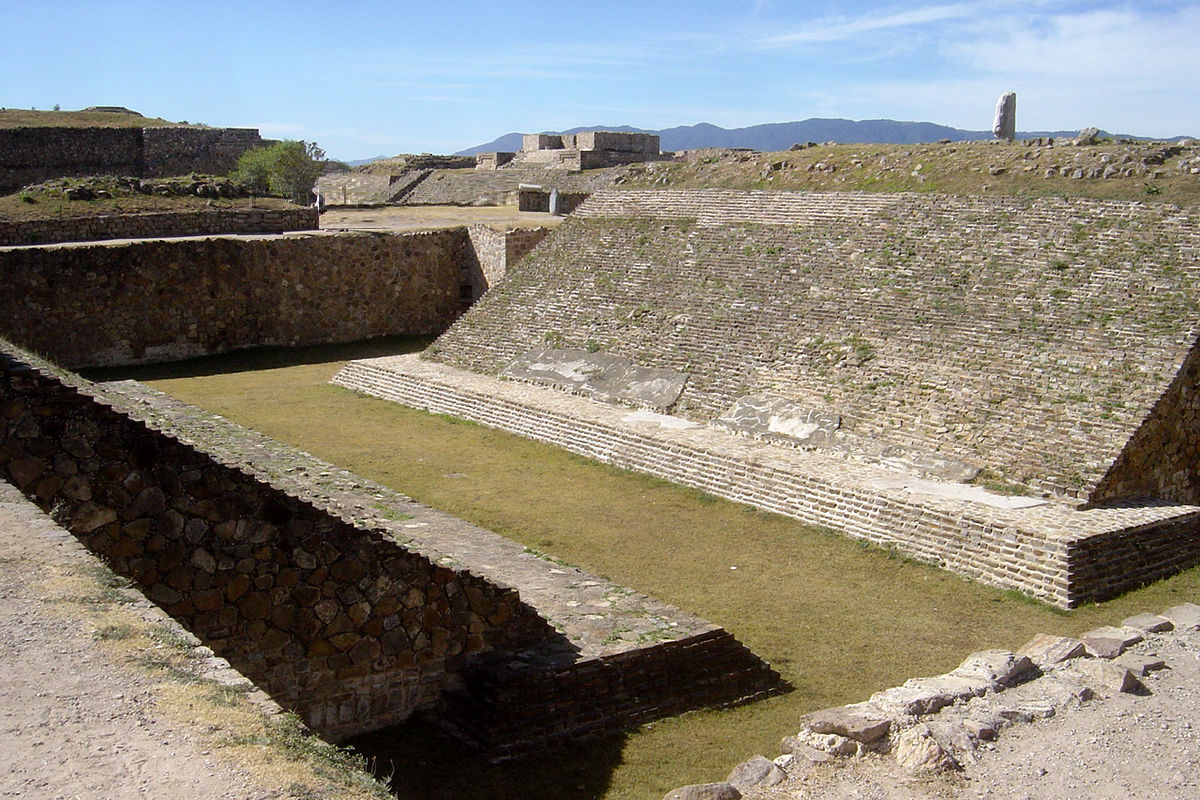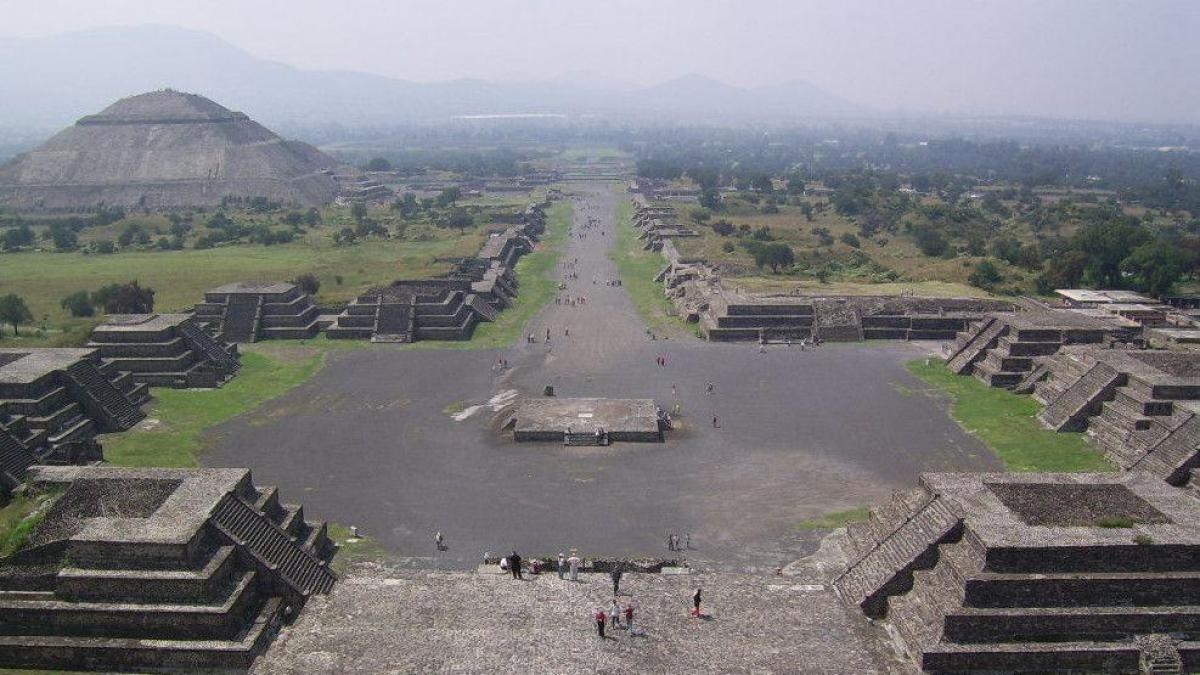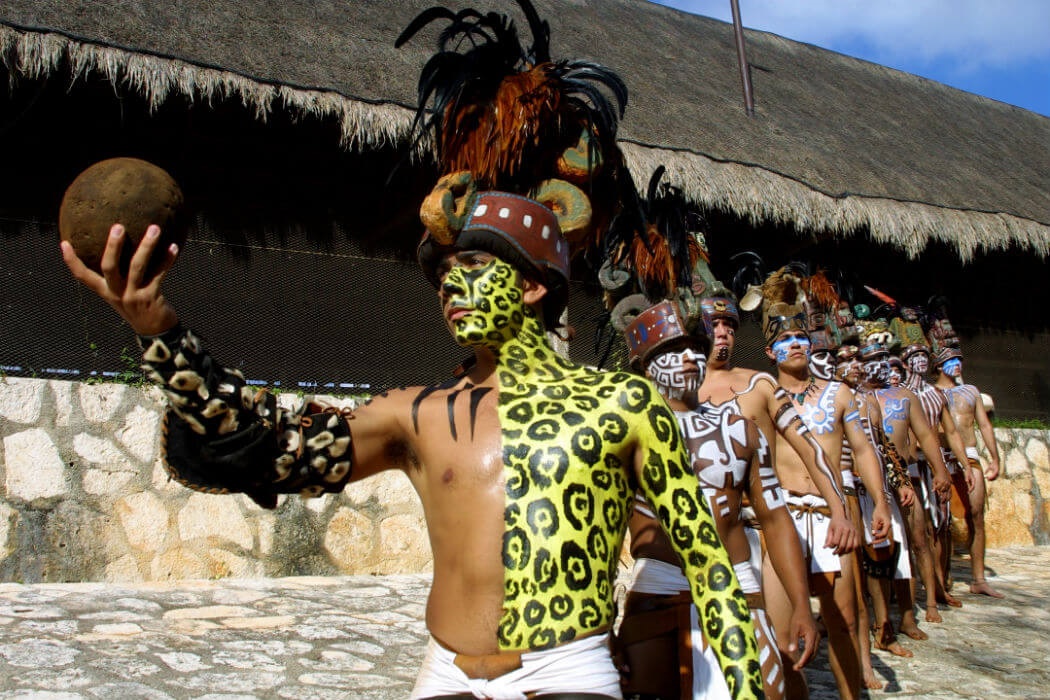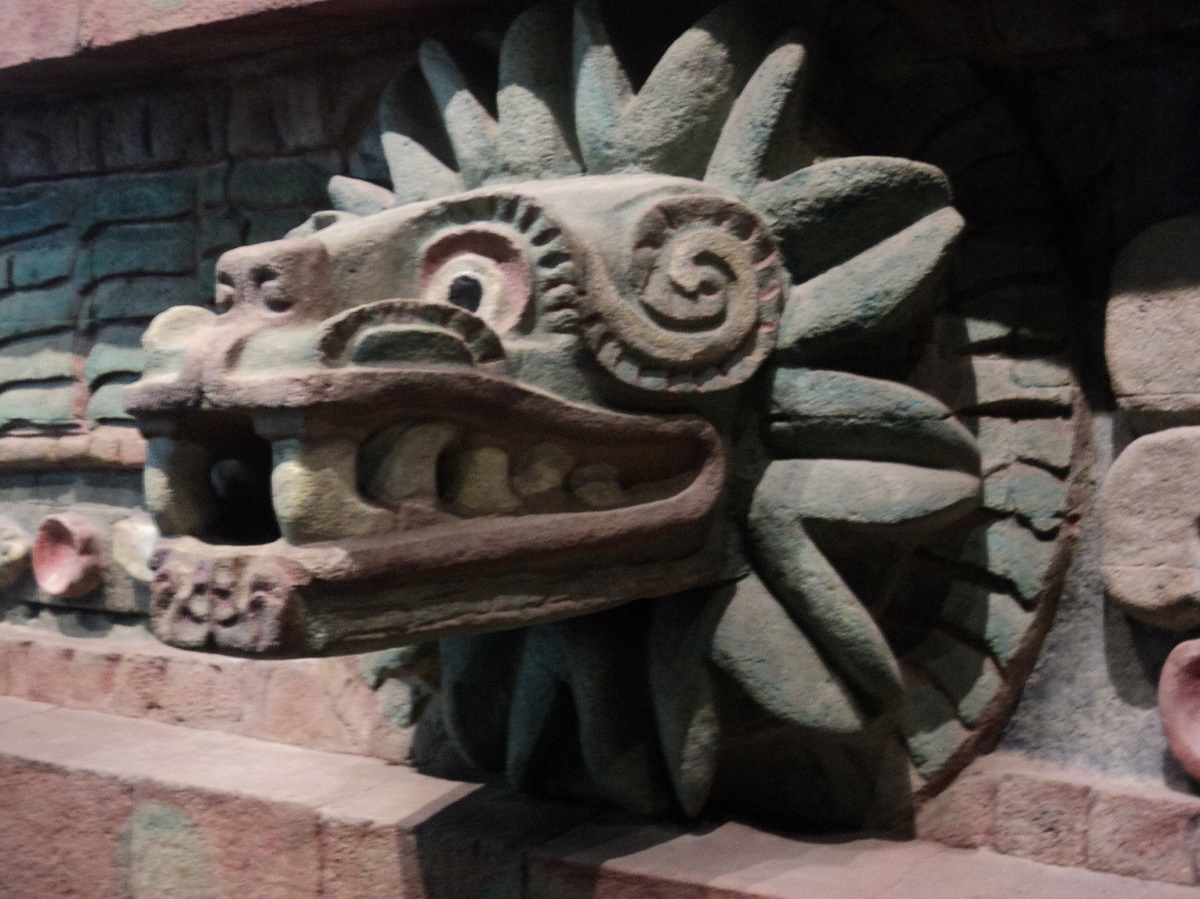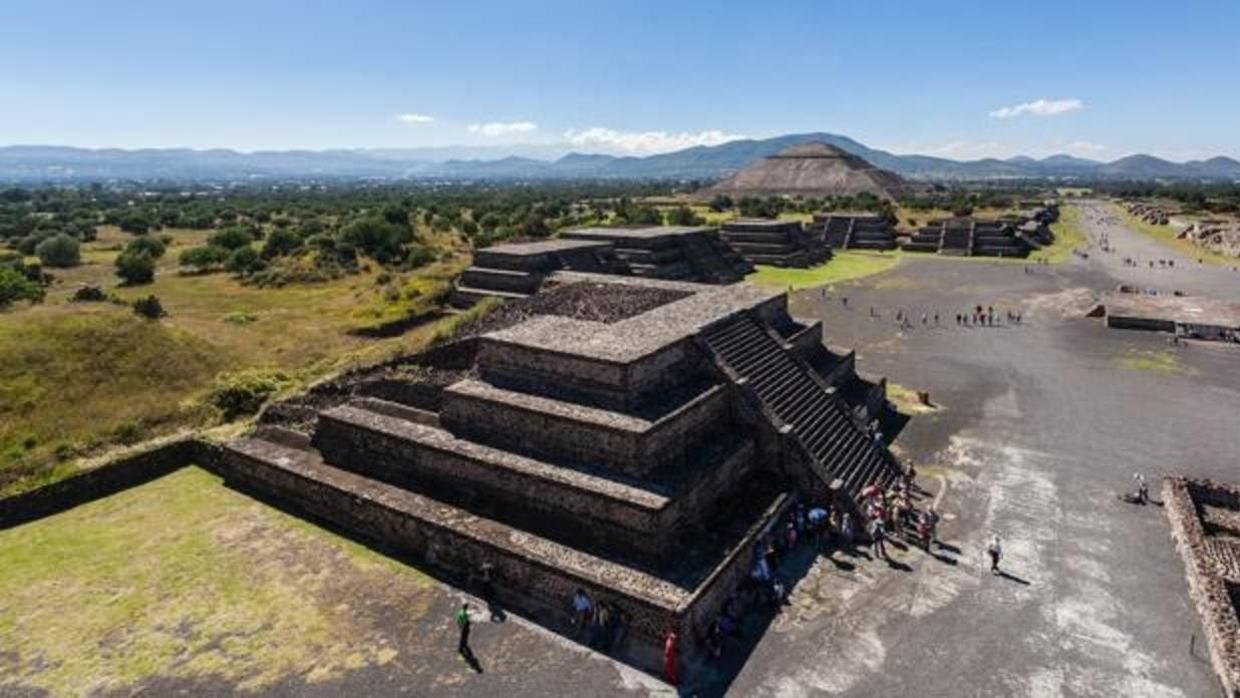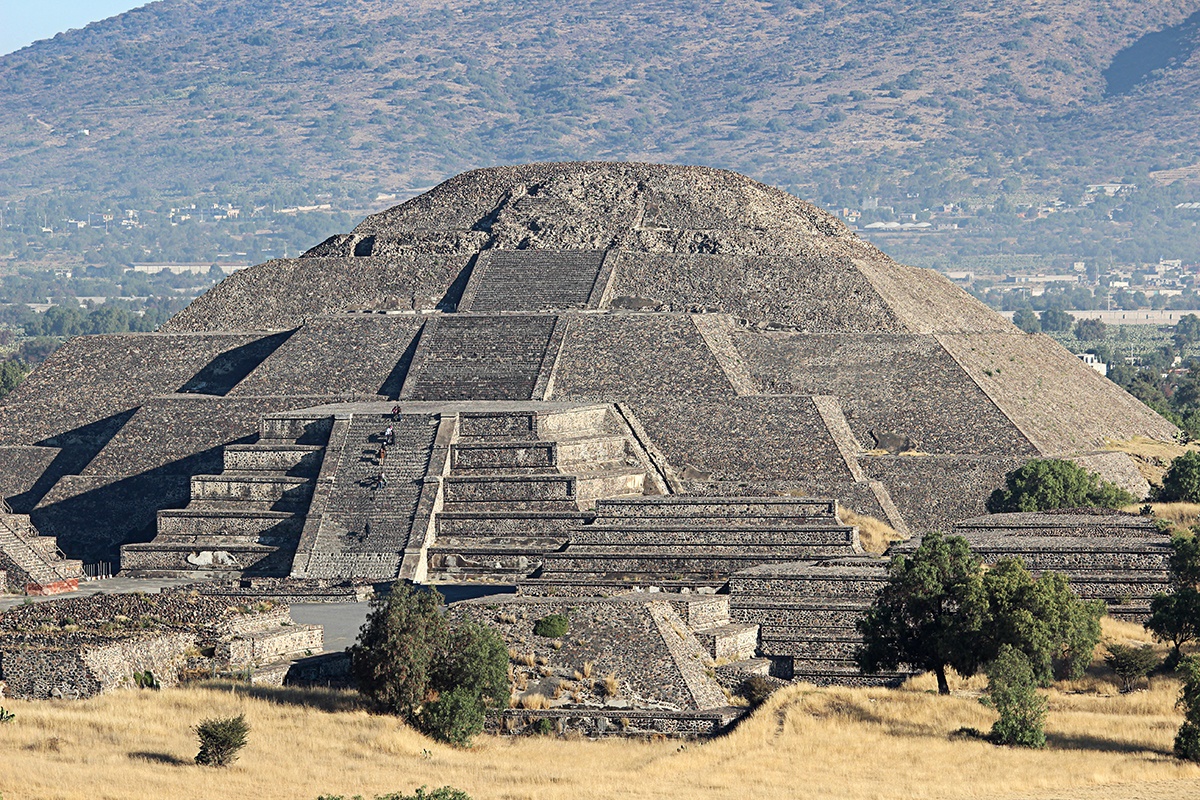In this article I invite you to know everything about the amazing Teotihuacan culture, one of the cultures of Mexico that was founded in a great city that became a great center of attention, but the city fell into abandonment for various reasons that are still currently seeking explanations keep reading and find out everything that happened .

Teotihuacan culture
To refer to the Teotihuacan culture, emphasis must be placed on the ancient city of Teotihuacán, a pre-Hispanic city located in Mesoamerica, known as “the place where men become Gods” in the Nahuatl language, it was also known as "the city of sun", according to the records that we have, the city is founded at some point in the XNUMXnd, XNUMXrd or XNUMXth centuries before Christ.
The name given to the city is from the Nahuatl language, a language that is spoken in Mexico and is used by the Mexicas who were a people that had Aztec traditions. But when this people arrived at the ancient city of Teotihuacán, it was already built and abandoned by a previous civilization, when the Mexica saw it for the first time it was already abandoned for a thousand years. At present, it is not known who the original settlers of the ancient city of Teotihuacán were.
What remains of the ancient city of Teotihuacán can be found in the northwest of the Valley of Mexico, between the Municipalities of San Martín de las Pirámides and the city of Teotihuacán (State of Mexico). At a distance of 78 kilometers from the capital of Mexico City. The territory occupied by the ancient city of Teotihuacán is about 21 square kilometers and has very important archaeological monuments and for this reason, in 1987, it was declared a World Heritage Site by UNESCO.
As mentioned above, the origins of the city of Teotihuacán are uncertain and currently its origin and founders are still being investigated by various specialists in the field, but it is known that at the beginning of the Christian era, the city of Teotihuacán It was a very important village, since it was a place where the gods were worshiped, it was located near the Anahuac basin. The strongest and most solid constructions that attract attention were made at the time of the first foundation.
As are the tests carried out on the excavations that were made to the Pyramid of the Moon. The city had a great flourishing in the classical period between the 21rd century before Christ and the XNUMXth century after Christ. During that time the ancient city of Teotihuacán had many advances in the commercial, political and social. In addition to a great Teotihuacan culture in an area of almost XNUMX square kilometers where it came to house from one hundred thousand to two hundred thousand inhabitants.
The influence of the Teotihuacán culture was felt throughout the Mesoamerican region, as was demonstrated in other indigenous cities, such as Tikal and Monte Alba, where large-scale archaeological discoveries were found and were closely related to the Teotihuacán culture. It is important to point out that the ancient city of Teotihuacán had its complications from the seventh century after Christ, due to many political problems.
Internal rebellions were also being carried out by some indigenous groups and the climate changes were constant and dangerous for the population, which caused a collapse in the city and the population began to emigrate from the old city to various regions of Mexico. .
To date, it is unknown who the first settlers of the ancient city of Teotihuacán were, and who formed the Teotihuacan culture, but specialists and researchers in the area have come to the conclusion that they could have been the Nahuas or the Totonacs, since both are indigenous peoples. indigenous people from Mesoamerica. There is also the indigenous people called the Otomi who inhabited central Mexico.
Although the most accepted hypothesis by historians is that the ancient city of Teotihuacán was a Cosmopolitan city, which means that different cultures were mixed in the city and that is why the Teotihuacan culture was born, in another investigation carried out in the Zapotec neighborhood, they discovered objects that came from the ancient city of Teotihuacán, in the same way objects were obtained in other regions of Mesoamerica such as the Gulf of Mexico and in the Mayan territory.
It is important to highlight that the city and culture of Teotihuacan have been of great interest to later and current societies until its decline, it is a matter of investigation, since the ruins have been carefully examined since pre-Hispanic times by the Mexica and Toltec civilizations. , since discoveries of objects from the Teotihuacan culture have been made, as well as the archaeological sites in the city of Tula and in the Great Temple of Mexico located in Tenochtitlan.
In the Nahua mythology of the post-classical era in the ancient city, the Teotihuacan culture had very specific myths such as the legend of the Suns, which consisted in the fact that the creation of the universe, the world and humanity took place in five different stages. from creation. This legend was supported by the population of the Mexicas.
In the present, the ancient city of Teotihuacán only remains but it is protected because it has the archaeological monuments and because of what it represents for humanity, in addition to attracting many tourists a year. Above the Yucatan peninsula where Chichen Itza is located. El Tajín and Monte Alba are other archaeological sites, much visited by tourists. With this, the Teotihuacan culture is expanding throughout the world.
The city of Teotihuacan
The city is called Teotihuacán and is of Nahuatl origin, but the name was given after several centuries of its end, as a great Cosmopolitan city where the Nahuatl people were. According to history but not confirmed. And when the Mexicas arrived in the city, they named it after the ancient city of Teotihuacán, although it had already been abandoned a thousand years ago.
In the colonial era of Mexico, the Mexicas began to make a tour of the historical sources of the Teotihuacan culture in Spanish. Although there are many misunderstandings in the culture of this ancient city of Teotihuacan. Since the Mexicas knew the city when it was already abandoned. For the Mexicas, the ancient city of Teotihuacán was a city of the past where there was a lot of cultural, social and political activity, even technology due to found objects.
There are many researchers, who affirm that the city of Tula flourished there, and it was thought that the inhabitants were of Toltec origin. Due to the meaning of the name given to the ancient city, there are many hypotheses, since in the Nahuatl language it is of agglutinative origin, for which many ideas of what the word Teotihuacán can be translated can be expressed.
One of the most accepted interpretations by the community and researchers is the one where it is translated “place where the gods were born” or in the same way you can say “Place where the gods were made” and this interpretation is combined with the myth about the Legend of the Suns. Which is a well-known myth in Mesoamerica that seeks to answer how the universe is created.
In Mexico, the city of Teotihuacán is highly respected by the Nahua community, who declare that the city was created through the creation of the fifth Sun, since all the gods of the previous era sacrificed themselves. In the Nahuatl Language Dictionary, written in Spanish, the word teotl means God, ti is a euphonic ligature, and the hua is a possessive article, finally the can that performs an action. In this way everything translates into "The place of those who have gods."
What is certain is that it is still unknown what was the real name that the city received, when it was in full swing by its true inhabitants. There are some texts that have been discovered of Mayan origin, where the term glyph with people who have origins from the Teotihuacan culture.
These people have been represented as very important in the Mayan cities of Tikal, Uaxactún and Bonampak. Emphasis is also placed on the word pooh that in the Mayan language has a meaning very similar to the word Tollan. That designates a fabulous city in the Teotihuacan culture. With the word tolan Emphasis was placed on a civilization located in Mesoamerica and that had a legitimate origin from the most dominant lineages of numerous cities that are named in Mayan texts.
The aforementioned is reinforced by the discoveries of various representations of glyphs in the paintings that were made on the walls of the residential complex of the ancient city of Teotihuacán. Although this Tollan is identified as the city named Tollan-Xicocotitlan, as the capital of the Toltecs.
But it is interesting to note that many researchers have separated the myth from the history of the city since there are other cities throughout Mesoamerica of great importance and they were called in the same way. Although it was not applied to the ancient city of Teotihuacán because it represents a city that is more mythological than historical, because doing an analysis of its history, it was found when it was already a thousand years old.
The archaeological finds that have been found in the Mayan city and in central Mexico, where many researchers have made associations with these archaeological finds and the myth of the city of Teotihuacán, they accuse that the union between the city Tollan and Teotihuacán is attributed to Tula mythology where men become gods.
Archaeologist Laurette Séjourné, who was born in Perugia, a city in Italy, and died in 2003, maintains this same perspective. At the Congress of Archaeologists, which took place some time ago. Where the mythological Tollan was established was Tollan-Xicocotitlan, and this theory is shared by other archaeologists such as Stuart, Uriarte, Duverger and René Millon and all these researchers are recognized specialists in the Teotihuacan culture.
All the aforementioned archaeologists accept that the ancient city of Teotihuacán is the legendary city of Tollan and it is not accepted that this is its real name. Since the ancient city of Teotihuacán is used to designate the historic city and all the archaeological discoveries that were made are in full view of the public, it is also known as the Teotihuacan culture.
Geographic environment of the city of Teotihuacana
In the ancient city of Teotihuacán that was founded in an unusual geographical environment, during the time of its own settlement near the basin of Mexico, during the Middle Preclassic. At that time, most of the large-scale settlements that were built were in the region near the banks of the Anahuac lake system or very close to it. Its cardinal points were Cuicuilco and Copilco in the south; Ticomán, El Arbolillo, Zacatenco, and Tlatilco in the north; and Tlapacoya in the east.
While the ancient city of Teotihuacán, is founded in the Teotihuacán valley and is part of the basin of Mexico. It was located fifteen kilometers from the shore of Lake Texcoco near the San Juan River in the valley that was named after the city.
The archaeologist Duverger in his investigations has affirmed that the location of the ancient city of Teotihuacán does not correspond to a single ecological border, but to the border between an agricultural civilization of Mesoamerica and the cultural world that was held in the nomadic Aridoamerican peoples.
The Teotihuacán valley is linked to the basin of Mexico, and is located in the northwest of the basin of Mexico, which has an area of more than 14 thousand square kilometers. And it is within the limits of the current state of Mexico, the height where the city of Teotihuacán was located is about 2240 meters above sea level to the highest point of Cerro Gordo that reaches 3200 meters above sea level and the area where most of the Archaeological finds are found at a height of 2300 meters above sea level.
The Teotihuacana Valley is limited to the north by the Cerros del Gordo, Malinalco and Colorado. To the south of the valley, it borders the Patlachique mountain range, which is an orographic formation and has an elevation greater than 2600 meters above sea level. To the east it is limited by the municipality of Otumba and other hills. To the southwest is located the valley and the Chiconautla hill. Where is the old mouth of the San Juan River.
Cerro Tonala is located to the west and marks the separation between the Teotihuacán valley and the alluvial plain where Tecámac and Zumpango meet. The drainage of the Teotihuacán valley is towards the Lake Texcoco glass through which the San Juan river passes, in the same way are the San Lorenzo and Huipulco rivers, but both rivers are seasonal since they are rivers that appear in the rainy season. with a strong current of water and then in times of drought its current of water disappears from the surface to re-emerge again in the rainy season.
The soils found in the Teotihuacán valley belong to four main types which are feozem with 40 percent, then vertisol with 16 percent and cambisol and leptosol with 13 percent each, and make up the soil surface from the valley. Several investigations have also been carried out on the floor of the Teotihuacán valley in order to determine the impact that human activity has on that place.
One of the companies that did those name investigations. Rivera-Uria et al. It has been reported that in some sites, such as Cerro San Lucas, the soil has changed its composition drastically, since evidence was found that before being populated in the Preclassic period, the dominant soil of the place was Luvisol. But now it has completely disappeared.
Other parts of the Teotihuacán valley have been affected since constructions have been carried out, in the case of the materials used for the filling that was used in the Pyramid of the Moon, it comes from the land that is close to the area where they were built. buildings, since artificial depressions have been found that have reached two million cubic meters.
Regarding the vegetation found in the Teotihuacán valley, it has changed a lot since pre-Hispanic times, when the ancient city settled and formed the Teotihuacan culture, but the current landscape of the valley is the result of the union of a series of natural and anthropogenic factors, and the main difference that exists is the extension of the vegetal ecosystems.
Well, agriculture in the Teotihuacán valley has grown at the expense of the indigenous people who first planted and still continue to do so, and the landscape of the valley has disappeared, which had a genus of plants called Pinuses.
At the present time, the Teotihuacán valley mainly presents six types of vegetation and has small oak-type forests, which are located on Cerro Gordo; but this was probably the type of vegetation that existed at the time of the ancient city of Teotihuacán. Which is the second vegetation that there is mostly and the most predominant vegetation is the xerophytic scrub and includes many species, the most common are Opuntia streptacantha, Zaluzania augusta and Mimosa biuncifera.
Then there are the grasslands which is the vegetation that is associated with the rainy season. The conditions of the land favored the concentration of the population as it is a quiet area and excellent for agriculture. The settlement date of the population is during the preclassic period between the years 2500 before Christ and the year 200 after Christ.
The first villages that were established in the ancient city of Teotihuacán were on the slopes of the hills, since in the upper part of the hills there was soil suitable for agriculture, but in the years 200 after Christ until the year 700 after Christ. The population increased drastically at the bottom of the valley, according to the researchers because it was a transition zone and it was a lacustrine environment of the Anahuac and the driest of the Tulancingo and Mezquital valleys, it was exposed to some climatological fluctuations.
The researchers also affirm that the illuviation, which is the process of soil accumulation, which was found in the clay of Cerro San Lucas, has a decrease in humidity that coincides with the increase in population, but during the heyday of the ancient city of Teotihuacán the environment according to the studies carried out was a little more humid and temperate than the current climate that occurs today.
Ethnic and linguistic culture of the Teotihuacanos
According to the investigations carried out by specialists in the matter, they have determined that the identity of the people who founded the ancient city of Teotihuacán is not known. But when the Spaniards arrived in Mesoamerica, the city of Teotihuacán had already been abandoned for a long time, that is why there are very few references to the ancient city, and those that do exist have been preserved by historical sources from years after the conquest of Mexico.
In addition, that the historical references that we have are not of the inhabitants of the city of Teotihuacán but of the inhabitants of the city of Anáhuac, who had lived there until the collapse of the ancient city of Teotihuacán.
The inhabitants of the Nahuatl city came to affirm that the city of Teotihuacán was the place where the gods met to give rise to Nahui Ollin, which means the fifth sun. As told in the indigenous mythology of Mexico, where researchers of the contemporary era are guided. This is what an indigenous poem predicts.
“While it was still night,
When there was no day yet,
When there was still no light,
They met,
The gods were summoned
There in Teotihuacan.
They said,
They talked to each other:
Come hither, oh gods!
Who will take upon himself
who will take charge
that there is a day,
That there is light?
In other historical sources from the colonial era, the Nahuas were convinced that the ancient city of Teotihuacán was built by the quinametzin, who in indigenous mythology were said to be giants that were created during the rainy sun.
These giants populated the world in the previous era and those who survived were very cultured beings, that is why the temples and pyramids that the city of Teotihuacán had, were believed to be the tombs of these beings who had founded the city, the This place is a sacred place where when they died they became gods according to the Teotihuacan culture.
“And they called it Teotihuacán, because it was the place where the lords were buried. Well, as they said: When we die, we don't really die, because we live, we resurrect, we continue living, we wake up. This makes us happy. They said: God was made there, it means that he died there”
But the inhabitants of the city of Sahagún affirm that the identity of the people who founded the ancient city of Teotihuacán was unknown, but there are many hypotheses that the true identity of the founders of the ancient city of Teotihuacán were the Otomi, an indigenous people which has a long presence in the Valley of Mexico. For this reason, it has been thought that they are the founders of the city and of the Teotihuacan culture.
Some historians have affirmed that the presence of the Ottomans in the city was very important, but it is considered that the class that dominated the ancient city of Teotihuacán was Ottoman. In the opinion of the researcher Wright Carr, both the indigenous elite and the other inhabitants of the ancient city of Teotihuacán, then must have been a proto Otomí-Mazahua, since it was a territory populated and very popular with other peoples of the Otomanguean and Totonac languages.
In analyzes that were carried out on the separation of the languages, between the Otomi and Mazahua, which according to what happened precisely in the peak period of Teotihuacán and has linguistic and archaeological evidence, where it is supposed that the language that the Teotihuacans spoke could have been the Mazahua, the Otomí, the Totonac, the Tepehua, the Popoloca, the Mixtec or the Chocholteco. There is also a probability that the people who lived in the ancient city of Teotihuacán will communicate in the Nahuatl language.
Other candidates to occupy the site as the true founders of the city of Teotihuacán are the Totonacos indigenous people. Since many chroniclers in the colonial era accepted that the Nahuatl language was used in the city but from the point of view of the culture of Coyotlatelco, which are associated with the end of the Teotihuacan city, but they expressed themselves in the Nahuatl language.
Likewise, the Totonacs are found as the population that could have been the founders of the city and the Teotihuacan culture. That is why the chroniclers who made studies of the Teotihuacan culture, in the colonial era, took several testimonies where it is affirmed that the Totonacs were the ones who built the city of Teotihuacán.
According to the linguistic expert named Lyle Campbell, it is in accordance with the historical evidence taken by the chroniclers of the colonial era. Since the language of the Totonacs provided many words in their language, to the other Mesoamerican Indians. Particularly to the Nahuatl and Mayan languages, where that language is spoken in the eastern highlands. That is why it is very certain that those who founded the ancient city of Teotihuacán spoke the language of the Totonacs.
History of the city of Teotihuacan
The history that has been investigated by the chroniclers and is the one that is documented, is that the Teotihuacan culture had its great apogee in the early classic period of Mesoamerica, which corresponds between the II, III, IV centuries, before Christ. Well, the beginnings of the city must place in the first millennium before our era and it is located in the northeast of Mexico.
It is located exactly near the shore of Lake Texcoco in the north of the country. That is why the city became one of the main competencies of the Cuicuilco city in the Late Preclassic era. Later, with the eruption of the Xitle volcano to the south of the valley, the city of Cuicuilco fell and the population emigrated to the ancient city of Teotihuacán and the great social, economic and political power was formed, giving rise to the Teotihuacan culture.
For reasons that have not yet been discovered, the ancient city of Teotihuacán collapsed in the XNUMXth century, giving rise to the Mesoamerican Epiclassic period. And the constructions that remained in the city give rise to many explanations about the presence of various indigenous peoples who made life in the ancient city, but the main one was the Nahuatl people in the postclassic period. All the information was collected by the Indian missionaries and by the historian Bernardino de Sahagún.
Chronology of the city of Teotihuacán
To carry out a chronology of the Teotihuacan culture, several investigations have been proposed that have been carried out on the ceramic archaeological objects found in the ancient city of Teotihuacán, since many of these objects were found in the different excavations that have been made to the city. Each of the phases carried out is related to the crafts of the city.
The procedure that was carried out has been able to simplify the mission of dating the archaeological objects found. Since the ceramic material in the ancient city is very abundant and in the area where it is found it tends to resist the passage of time and is present throughout the Teotihuacan culture.
But the procedure that is carried out sometimes becomes very complex, because it does not give you a precise definition of the characteristics of how the ceramic object was made and how it is delimited in time. For the reason that many researchers have focused their knowledge on the Teotihuacan culture, there are many chronologies made of the ancient city.
But the best known and accepted by specialists and researchers is that of archaeologist René Millon and his team, but there are other researchers who claim that the archaeologist's chronology should be more accurate, since researchers George Cowgill and Evelyn Rattray, made the proposal that the fall of the ancient city of Teotihuacán occurred between fifty and one hundred years before the chronology suggested by René Millon.
The prehispanic period
In the Teotihuacan culture it is understood as a long and varied process that began with the arrival of the indigenous people to the Anahuac, this happened about twenty thousand years ago, at this time the discoveries made in the city of Tequixquiac were dated, which today It is one of the 125 municipalities of Mexico, after the discoveries that were made in the cities of Tocuila and Tlapacoya.
In the city of Tlapacoya, deposits were found where there were two human skulls and the remains of various animals along with many stone tools. They also learned to domesticate various types of animals and many plant species on which their main sources of food were based, this is located in the seventh millennium before the Christian era began.
Agriculture in the area favored the indigenous population the process of sedentarization and on the banks of the eastern river of Lake Chalco a town was established that is currently a site called Zohapilco. Whose first phase could have been carried out in the years 5500 BC until 3500 BC. By that time, the indigenous people who had populated the city of Zohapilco were already using farming tools and utensils for processing the grains that they themselves sowed and tools for hunting.
In the year 2000 before Christ, the production of ceramic objects began, but agriculture became the first point of the economy of the indigenous peoples that inhabited the Valley of Mexico, since it provided a secure source of food and the As the population grew, it settled around the Anahuac lakes where there were numerous villages and this became more difficult due to the different social classes that were emerging.
During the Middle Preclassic period, which was between the years 1200 and 400 BC, where all the villages reached great influence, such as the one with the highest hierarchy, which are Tlatilco, Copilco and Cuicuilco. All these villages made a combination between agriculture and the maritime resources that they had and there was a mixture between various cultures thanks to the inspiration of the Olmec people and other cultures from the west of the country.
The indigenous town of Cuicuilco was the main economic, political and cultural center in the Valley of Mexico in the year 600 BC, at its time of greatest influence it had some 22 thousand inhabitants, but other investigations determined that the city It had more than 40 thousand inhabitants. It was the first place where the first pyramids of Mesoamerica were built and they worshiped the God of Fire, since they were very close to the Xitle volcanoes.
In the year 100 BC, one of the volcanoes on the Xitle hill erupted and buried the village of Copilco and part of the village of Cuicuilco with lava. But there are several stories about what the Cuicuilco population had to live through, and many researchers affirm that they participated in the founding of the ancient city of Teotihuacán and the Teotihuacan culture. Because of what happened to his village and the eruption of the volcano.
But the migrations that took place to the city were before the Xitle volcano expelled the lava. Many researchers have also affirmed that the city of Cuicuilco was the rival of the ancient city of Teotihuacan. But the city was also disappearing and it is still not known why, but it is said that it declined between the years 200 before Christ and the year 200 after Christ. There is no exact date.
The first place in the city of Teotihuacán
There is not much exact information about the first place where the ancient city of Teotihuacán is located, but it all begins in the Middle Preclassic period, when a group of indigenous villages that are dedicated to agriculture and were developed in the Teotihuacán valley. contemporary with the Terremote Tlaltenco, Tlatilco and Cuicuilco villages. And its development phases were linked to Cuanalan and Tezoyuca between 500 years before Christ and 100 years after Christ.
In the development phase of Cuanalan is where the first villages are established in the Teotihuacan valley since they take advantage of the conditions of the territory and the climate it has to start practicing agriculture, the other villages settle near the lake routes to take advantage of the benefits of rivers and springs. To the north of the Teotihuacán valley, the oldest settlements are made on the valley of the Sierra de Patlachique.
According to some hypotheses highlighted by archaeologists where they speculate that in those first settlements they could be from the Otomi or Popoloca indigenous people. But there is no evidence that certifies or ensures that these were the inhabitants of the ancient city of Teotihuacán.
In the phase that was known as Tezoyuca, there was a pattern of five settlement phases that, according to the investigations carried out, were defensive functions since the deposits corresponding to that time are influenced by the Chupícuaro culture that was developing in the Bajío at that time. weather.
Arrived in the year 100 before Christ, two settlements were being built that would later become the metropolis of Teotihuacán. In one of the settlements, what corresponds to the area where the ceremonies of the city of Teotihuacán were held on the road of the dead. In the phase named Patlachique, it is estimated that there was a population of five thousand people and places the city of Teotihuacán with an important rebound in the next phase.
It should be emphasized that the increase in the population in the city of Teotihuacán is due to everything that was happening in the village of Cuicuilco, where many indigenous people were abandoning it due to climate problems in the area. Although the location of the ancient city of Teotihuacán was strategically so that it would be favored by agriculture and ensure the supply of food to the entire city.
The areas of the valley that were found with springs such as the Sierra Patlachique and Cerro Gordo show a greater population since the conditions were the best for high-impact agriculture and there are several hypotheses where the elite of the region has been located in that settlements. And having formed a Teotihuacan culture.
The process that was carried out to design the urban planning that led to the foundation of the ancient city of Teotihuacán received a great cultural contribution from the Cuicuilca people, since they were the owners of a very difficult but well-organized social organization that strengthened the organizational structure of the city. ancient city of Teotihuacan. Another point in favor of the city is that the location it was given made it relatively easy to access the strategic resources that existed throughout Mesoamerica.
At that time, the opportunity arose to exploit the obsidian deposits in Otumba and the Sierra de las Navajas, in addition to much of the products that were extracted from Lake Texcoco. As well as the water from the springs of the Pa Tlachiques hill and the control that is carried out on the commercial routes of the time that existed between the Anahuac and the coast of the Gulf of Mexico.
All these points are important factors and form the scenario that led the city of Teotihuacán to a great city and formed a political and social project, thus realizing the Teotihuacan culture and forming one of the most powerful cities in the history of Mesoamerica.
In the next phase called Patlachique, the urban center of Teotihuacán is already consolidated, and the old city experienced a large number of settlers who are estimated to have reached the basin of Mexico with a population of more than one hundred thousand indigenous people. Of which 25 populated the ancient city of Teotihuacán and as many of the population belonged to the city of Cuicuilco that had arrived due to the decline and eruption of the volcanoes.
The population that was near the alluvial plain of Lake Xochimilco, had the ancient city of Teotihuacán as its greatest political rival since they had control of the basin of Mexico. And there are hypotheses that there was war and armed confrontations for the raw material of Tezoyuca ceramics that was found in the highest of the hills of the city of Teotihuacán, in this way the city has a greater political and cultural role.
In this way it attracts a large number of the existing indigenous population thus increasing its population considerably. Although there is a hypothesis that the city of Cuicuilco had come to an end due to the eruption of the Xitle volcano, which is said to have covered the entire village with lava, they have come to affirm that the city perished due to the events mentioned above.
Beginnings of the city of Teotihuacán
To continue documenting the Teotihuacan culture, it is essential to describe the beginnings of the ancient city of Teotihuacán, since in the year 100 BC the ancient city of Teotihuacán was concentrating a large number of indigenous people in almost the entire Anahuac Valley. In addition to that, the indigenous people who were emigrating from the city of Cuicuilco to depopulate it and look for a new settlement in the city of Teotihuacán.
There was another phase called Tzacualli de Teotihuacan that occurred between the years 1 and 150 after Christ, in this stage the bases for the urban planning of the city are being established and it is at this point where several very characteristic points of the culture are being defined. Teotihuacan, at that time they begin to build buildings in the city of Teotihuacán that are designed around two axes, the north south axis which goes and constitutes the Calzada de los muertos, which in the Tzacualli phase is already well planned .
Well, it is geographically located at degrees 15° 28' pointing east with respect to the geographic north and the east-west axis that was planned by the course of the San Juan River, whose course had to be diverted to make it coincide with the geographical position 16° 30' south of east. At that time, the first stage of the Pyramid of the Moon was being built, and the plaza of this great building that marks the northern limit of the road of the dead was also well planned.
It is very important to emphasize the effort that was made to build the Pyramid of the Sun in the Teotihuacan culture, since it was built practically in a single stage that is documented in this phase called Tzacualli, during that phase the center of the city was marked by this construction that was the representation of the maintenance mountain and is constituted by the axis beat according to what is written in the Teotihuacan culture.
The platform for the Pyramid of the Sun may have been built at the end of the Miccaotli phase. According to the work carried out by René Millon, in the Tzacualli phase the population of the ancient city of Teotihuacán was around 30 indigenous inhabitants, in an area of 17 square kilometers, at the time of the phase mentioned above.
That is why it is unquestionable that the ancient city of Teotihuacán was the city of central Mexico and could only be compared with the cities of Monte Albán located in the Central Valleys of Oaxaca and with the city of Cholula located in the Tlaxcalan valley of Puebla, in the excavations. Archaeological investigations that have been carried out in the ancient city have found many remains of granular ceramics, which is a raw material that was found in the deposits of Morelos and in the center of the state of Guerrero.
This leads researchers to suppose that in the ancient city of Teotihuacán it had commercial relations with different areas of Mesoamerica and that they were active when the Late Preclassic began. Between the years 150 and 250 after Christ, it corresponds to the Miccaotli phase. In this phase it is called by this name because the Nahuas choose the Calzada de los Muertos, in this way the city is consolidated as one of the cosmopolitan cities in central Mexico.
In the center of the ancient city of Teotihuacán they moved towards the South arriving at the construction of the citadel, which is an enclosure very similar to the Pyramid of the Sun where the primordial sacred mountain was represented. The citadel is built with thirteen temples distributed around a large square where the pyramid of the Feathered Serpent is located.
A very important fact about the Pyramid of the Feathered Serpent, that several sacrifices were made that number more than one hundred people and were placed in collective burials in various groups of 4, 8, 18 and 20 bodies, plus other bodies that were buried alone in each corner of the building's bases, there are also several children who were sacrificed and discovered by archaeologist Leopoldo Batres at each vertex of each level of the platform.
In a very similar way to the construction of the citadel, the ancient city of Teotihuacán was organized in four quadrants, as were the constructions of the East and West avenues, both of which form an axis almost perpendicular to the Calzada de los Muertos, since they advance from the citadel towards each cardinal point and mark a division of each quadrant of the city.
In the Miccaotli phase, the Pyramid of the Moon was enlarged twice, the first between the years 150 and 200 after Christ and the other in the year 225. The archaeologist René Millon in his investigations was able to calculate that the population of the city of Teotihuacán could have reached 45 inhabitants in the Miccaotli phase, and the city had an area of 22,5 square kilometers, the largest size it had in its entire history.
Although the population was always growing in all stages, the great constructions that were carried out at that time reveal that the city was a great political and cultural center of Teotihuacan and of great relevance for all of Mesoamerica and that is why it attracted many indigenous populations from other regions of Mexico and the most important case was that of the Zapotecs who settled in Tlailotlacan in the second century.
The flourishing of the city of Teotihuacán
For the year 250 after Christ, the Tlamimilolpa phase begins, and they take that name from the outskirts of the city of Teotihuacán. During the present phase in the city of Teotihuacán, regional power has been consolidated and it has great influence throughout Mesoamerica. The pyramid the Moon enlarges it more twice in this phase. The fifth stage of construction of that building was around the year 300 after Christ.
The sixth stage of construction is located between the years 0 and 350 after Christ. In the same way as it was done in all the previous stages, many human sacrifices were made
The demographic expansion of the ancient city of Teotihuacán was planned in a very organized way in several housing complexes, since this practice had been carried out in the previous phases and was adjusted to the urban plan of the city with respect to its two axes. Several older housing complexes such as the the window they were enlarged and provided with spaces for public activities.
New rooms were built, but a disadvantage is that the surface of the city shrinks during the stage since it remains in about 20 thousand square kilometers, two square kilometers less than in the previous stage but the population of the city increased according to the calculation that René Millon did where he could have reached the 65 thousand inhabitants of the city.
In the archaeological investigations that were carried out in the Tlamimilolpa phase, archaeological objects made of ceramic were discovered Orange Thin is a ceramic of great diffusion in Mesoamerica but an emblem in the Teotihuacan culture, in this phase 6 percent of the ceramic materials and then it increases throughout the following stages, this ceramic is very important in the deposits and is considered as an indicator that links the entire Teotihuacan culture with Mexico.
But ceramics is a foreign product that does not belong to the Teotihuacan culture, as stated by the researcher Carmen Cook, who was the main ceramic producing center in Puebla. Rattray agrees with this research and adds that in the Tepexi de Rodríguez region, This culture flourished as it maintained a very strong relationship with the ancient city of Teotihuacán but did not subordinate the city.
The relationship that the ancient city of Teotihuacán had with all the regions of Mesoamerica diversified during the Tlamimilolpa phase, as it was demonstrated in the archaeological evidence found. In burial number five of the pyramid of the Moon that was offered in commemoration of the culmination of the work, the three main subjects of the burial were placed in the position of the lotus flower.
Also along with them were jade objects that were native to the Motagua River Valley. The position in which the human remains were found is similar to what was done in the burials of the elite in Kaminaljuyú (Guatemala). This discovery is of great architectural influence that the ancient city of Teotihuacán had its great prosperity on the Mayan knowledge as was the city of Tikal and Kaminaljuyú itself.
Several Mayan pieces were also discovered in the Tlamimilolpa horizon of Teotihuacán, in addition many of the ceramics that were found were of the Tzakol type and have many characteristics with other works since the Mayan presence in the city of Teotihuacán was added the same as that of the Zapotecs in the Miccaotli phase.
Conquest of the city of Tikal
For the year 378 after Christ, for the month of January, the ancient city of Teotihuacán was governed by a character named Atlatl Cauac, which translated into Spanish means the Owl Thrower and was the governor of the ancient city of Teotihuacán, the Teotihuacan warrior Siyah K'ak' (Fire is Born) "conquered" the city of Tikal.
What they did was to remove and replace the Mayan king who directed the city of Tikal, with the support of the city of Peru, which today is also an archaeological site of the Mayan culture that is located very close to the San Pedro River in the department of Petén in Guatemala.
It also had the participation of the inhabitants of the city of Naachtún, which is also an archaeological site of the Mayan culture, this entire event was recorded on Stela 31 of Tikal and other monuments of the Mayan region.
The conquest of the city of Copán and Quiriguá
For the year 426 after Christ, one of the founders of the Yax Kuk Mo dynasty that ruled the Mayan city of Copan for almost four centuries, this was recorded in what is now the country of Honduras, as described in Altar Q of Copan.
It is located in the Xolalpan phase, which goes from the year 450 to 650 after Christ, at this stage the ancient city of Teotihuacán has a lot of influence throughout the Mesoamerican region, since everything that is done in the city has repercussions on other indigenous cities. and thus the Teotihuacan culture is promoted, in addition to being the subject of discussion among the other indigenous cities.
Many researchers agree that the expansion of the Teotihuacan culture was the product of commercial transactions, which is why it explains how the Thin Orange pottery was found in various deposits in various regions of Mesoamerica, other researchers have the hypothesis that the ancient city of Teotihuacán was a state with a great military power and the city had a great expansion by means of arms.
But the researchers have agreed that the influence of the Teotihuacan culture was due to many factors, among which are trade, weapons and political alliances that occurred in those stages, as there were years of great boom in the architecture of the city. reached its greatest expression and the layout of the Calzada de los Muertos, as can be seen today as an archaeological zone. It corresponds to the Xolalpan stage.
The housing precincts of the city have indications of having benefited from the economy and culture of the city, since the cases of the neighborhoods that are well documented through archaeological excavations are observed, especially in the city of Teopancazco, since the inhabitants of this city had a higher level than in the previous phase. Since the city was organized by housing blocks and narrow alleys and there could have been a population of 85 thousand indigenous inhabitants.
This data is the result of research carried out by René Millon, but other historians say that more than 300 indigenous people lived in that city, but in any case it can be argued that at the time the city was able to reach its highest peak of population density and consolidating itself as the city with the highest hierarchy in all of Mesoamerica and one of the largest in the world at that time.
The city of Teotihuacán had a large sewage and drainage system that allowed all of the city's wastewater to be evacuated. The Teotihuacan culture was also highlighted at this time through art, in the Xolalpan stage many representative objects have been found such as the braceros, some pieces where the direct molding of various objects was carried out, there were also the murals of Tepantitla, those of Atetelco and the wall of the Jaguars of the palace of Quetzalpapálotl correspond to this stage.
The decline of the city of Teotihuacán
In the Metepec phase that begins around the year 650 BC, according to research carried out by René Millon, the city has about 75 inhabitants, which represented a loss of 25 percent compared to the previous phase named Xolalpan. With this demographic decline, the city of Teotihuacán had the privilege of being the most influential city of all the regions of Mesoamerica. Architectural activity greatly influences the Teotihuacan culture that spread throughout all regions.
But at this stage the architectural activity is paralyzed, although the only building that could be completely finished was the platform that supports the Pyramid of the Feathered Serpent. The platform was built to hide the building that was the great center of attention in the city and is the emblem of power of the city of Teotihuacán.
That is why the inhabitants of the city during this phase were not able to see the Temple of the Feathered Serpent, which can currently be seen in the archaeological zone, since its façade had to be rescued in the XNUMXth century.
According to the investigations carried out by René Millon, in the Citadel the buildings that were there were around the Causeway of the Dead where it was the object of systematic destruction by the inhabitants of the city, reaching the following point of the investigator.
“The center was not consumed by an extensive fire. The temples and public buildings were not simply destroyed, but dismantled, burned, reduced to rubble again and again on both sides of the avenue for more than a mile […] This is because those who started this process wanted to be sure that no power or no force of the Teotihuacan state would be reborn from those ruins”
Then in the Oxtotipac phase that is located between the years 750 and 850 after Christ, the population that lives in the city of Teotihuacán is drastically reduced since there is a massive exodus of inhabitants, René Millon in his investigations makes a calculation in this stage where the urban area of the city was inhabited by 5 thousand people and some parts of the city remained populated, among the most important that remained populated were the Old City and the places that were populated by the elite of the town.
Although this occupation of the city is closely related to the culture of Coyotlatelco, and the appearance of pottery that bears that same name, although researchers have expressed that the culture is foreign, a product of all the migrations that have emerged in the culture Teotihuacan, but other researchers have claimed that it is an expression of groups outside the city who had no knowledge of Teotihuacan culture.
To explain the case of the decline of the ancient city of Teotihuacán, several hypotheses have been made, but the one that researchers are most correct is the one that happened in the seventh century when a great drought occurred in the north of all of Mesoamerica and this caused the emigration of the indigenous population to the south of Mesoamerica, since the drought affected all agriculture in the city and the region, and caused the inevitable maintenance of the population.
However, the archaeologist McClung de Tapia and his collaborators have reported that these hypotheses do not have any indicator on which they can be sustained, since at the time of the city's decline it was possible to observe that the humidity increased around the city, since the time in which the city of Teotihuacán began to decline, other cities in Mesoamerica began to flourish since many had adopted the Teotihuacan culture.
This would be a factor that had contributed to the decline of the ancient city of Teotihuacan, the other cities that formed a crown with respect to the city of Teotihuacán had strategic points in the most important commercial routes in the Mesoamerican region. As was the Xochicalco in the Morelos valley, Teotenango in the Toluca valley, Cacaxtla in the Tlaxcala valley, Cantona in the east and El Tajín in the pass towards La Huasteca; all of these cities saw a flourishing while the ancient city of Teotihuacán fell into decline.
There are many researchers who affirm that with these new regional powers they ended up strangling the ancient city of Teotihuacán until depriving it of all access to trade routes.
The migrations that took place after the fall
Currently there are still debates about the origin of the groups that carried Coyotlatelco pottery, but researchers still debate that the appearance of these groups is closely related to the decline of the city, also the critical situation of the city was accompanied by the massive migrations that occurred and were abandoned that began in the year 500 after Christ.
This was verified with the archaeological evidence found in the north of the state of Morelos, where the presence of Teotihuacan settlers who joined with the local settlers and lost their Teotihuacan culture was determined, as a strategy to survive the oppression suffered by the Teotihuacan town.
The Teotihuacan disintegration that was established in different places far from the ancient city of Teotihuacán, this was verified during the Metepec phase that was between the years 550 and 650 after Christ.
During this time the city of Teotihuacán as a great metropolis dominated the north of the basin of Mexico, but the towns that were to the south of Mesoamerica and those that were to the west had no connection with the influence of the city, since there are investigations where it stands out that there was no contact with other materials from the other towns along those directions.
In this way, in the east of the Anahuac, to the north of the State of Morelos and the valley of Tlaxcala and the valley of Toluca, they had to absorb a large Teotihuacan population after the abandonment of the city, when the groups that carried the Teotihuacan culture were in the basin. of Mexico could have had a great demographic rearrangement and there was a diffusion of Coyotlatelco pottery.
Between Azcapotzalco and Ecatepec there are several populations that used this type of ceramic in the use of objects in the Toluca Valley, there is also another group of indigenous settlers who were in the Chalco-Xochimilco basin. And the third group and the largest that were concentrated around the Portezuela that settled in the Epiclassic period between 650 and 950 after Christ.
The last Coyotlatelco group corresponds to the one that stayed in the ancient city of Teotihuacán and was able to occupy the abandoned and ruined buildings which were Tula, Cacaxtla, Cholula and Xochitécatl since they were strategic points that were outside the city of Teotihuacán and very near the basin of Mexico, but objects made with Coyotlatelco pottery were also found there, although to a lesser extent.
Urbanism of the city of Teotihuacán
It is important to point out that when the city of Teotihuacán began to be planned, a very well-structured urban project was being carried out around two axial axes, the Calzada de los Muertos, which was between the north-south axes, while on the other avenue which began at the Citadel and was situated between the east and west axes.
Therefore, the San Juan River had to divert its natural course so that it crosses the Calzada de los Muertos perpendicularly. With these two main axes, a grid was drawn that served as the basis for the construction of the different residential buildings and temples, in addition to the pyramids.
The urban planning of the city of Teotihuacán acquired a prominent form around the third century after Christ, when the fourth stage of the city was already built, which was the pyramid of the Moon, the Citadel and the pyramid of the Sun. the city that was arranged on the Calzada de los Muertos and on the Avenida Este and Oeste were defined in the Tzacualli name phase, which ranges from approximately 1 to 150 AD. c.
The Calzada de los Muertos is a great road that crosses the city and begins in the Plaza in front of the Pyramid of the Moon and continues two kilometers to the south near the remains of the residential buildings named Teopancazco. . The avenue is oriented between 15º and 30' with respect to astronomical north.
But this deviation is the same that is observed in all the buildings that were made in the city of Teotihuacán, in the great avenue there are important residential and monumental complexes of the ancient city of Teotihuacán, the main religious activities were also practiced and on the road of the dead was the pyramid of the Sun next to the temple of the mythological animals and the temple of Quetzalcóatl.
The heart of the ancient city of Teotihuacán was made up of the aforementioned buildings and others that were dedicated to worship and very close to the buildings were the residential complexes of the city's elite, such as the palace of Quetzalpapálotl and the residential complexes from Yayahuala, Tetitla, Xala and Zacuala.
The neighborhoods that were the lowest strata of the city were organized around the central zone of the city and were made up of agricultural workers and artisans, as well as merchants and foreigners, according to the data that the different research that has been done.
The ancient city of Teotihuacan had about two thousand residential rooms in its greatest heyday and this occurred between the 20nd and 25th centuries after Christ, since the buildings were constantly expanded while they were remodeled to meet the needs of the population. and the surface of the city reached 30 square km in the Tzacualli phase, and the population reached XNUMX to XNUMX inhabitants.
But it is interesting to note that the ancient city of Teotihuacán had a large system of highly advanced urban services in which the management of water both for human consumption and the use of wastewater stands out, since it had a large network of sewers that helped to clean up the environment of the big city and the thousands of inhabitants who lived in that place.
The architectural integration that was made to the urban plan of the city of Teotihuacán is closely related to the worldview of the society that created it and the environment where it was located. Well, the urban layout of the city is marked by two slightly different orientations, which resulted from the combination of various astronomical and topographical criteria.
In the central part of the city, the Calzada de los Muertos is included, where the direction is adjusted towards the pyramid of the sun, while the orientation that is towards the south is oriented towards the Citadel and the two constructions mark the sunrises and sunsets. on particular dates of the year. Since they were allowed to use the calendar observing agricultural programming and ceremonies.
The fact that both orientations will be carried out belong to highly diffused elite groups throughout Mesoamerica, since it can only be explained by making use of astronomical references on the horizon.
The pyramid of the sun was also built so that it was aligned with Cerro Gordo to the north, this means that when the construction site was studied, many factors were taken into account, in addition to the artificial cave under the pyramid, which represented a place of great importance for Teotihuacan culture is also very important the relationship that existed between the most important constructions of the city and the forms of the Patlachique mountain range that surround the entire valley of the city of Teotihuacán.
The architecture of the ancient city
In the Teotihuacan culture it is important to highlight the architecture of the ancient city of Teotihuacán, since in the great road it has a distance of 40 meters and is deviated slightly towards the northwest 15º 30' with respect to the geographic north. Along the street are the most important buildings and temples, as well as the palace and the houses of the most senior characters for the time.
Among all these constructions are the two pyramids, the House of the priests and the Quetzalpapalotl (Quetzalmariposa) palace, next to the palace of the jaguars and the great structure of the plumed conches, the temple of Quetzalcóatl, the citadel and many more buildings than in their day was of great beauty.
In one of the floors of the temples they were built by two layers of XNUMX cm thick sheets that were later covered with tezontle. The tourist who wishes to contemplate this curiosity will be able to see it whenever they ask the guard of the enclosure.
The pyramid of the sun: it is the largest building built in the city and is one of the icons of the Teotihuacan culture and is the second largest pyramid in all of Mesoamerica, since the largest is the pyramid of Cholula which is more than 400 meters high, but The Pyramid of the Sun has large dimensions that can be seen from afar but it is only 63 meters high, with a plan of almost 225 meters on each side.
The Pyramid of the Sun is often compared to that of Cheops in Giza located in Egypt. The construction of the pyramid of the Sun has five superimposed frustoconical bodies and an attached structure of three bodies that do not reach the height of the first platform. On the eastern band, the Pyramid of the Sun is located near the Calzada de los Muertos, practically in a perpendicular line.
A restoration was carried out between 1905 and 1910 by the archaeologist Leopoldo Batres, since it was in commemoration of the Centennial of the independence of Mexico and several buildings were enabled to become tourist sites, although this restoration was highly criticized since it was done in a very hasty way and it was incomplete and Egyptian architectural conceptions were taken instead of the Teotihuacan culture.
At the beginning of the city of Teotihuacán, the place where the pyramid of the Sun was going to be located corresponds to a kind of wall with a slope base, and it was not associated with other structures, at present there is no record of how it was he used the Pyramid of the Sun. Although several researchers have suggested that it was a sacred space, the building was also built in two stages, in the first one it was completed until it reached all the dimensions it has.
The second stage only made minor modifications and some additions, but the use that was given to this great building is still unknown to humanity, in 1971 the archaeologist and researcher Jorge Ruffier Acosta, doing his work, found a tunnel under from the Pyramid of the Sun and access is from the front of the attached platform.
The tunnel had a name which is the sacred cave after doing several investigations in the place, archaeologists have hypothesized that it was used to perform purposes and rituals, and that explains the purpose of such a large structure, evidence has also been found that the cave was excavated by humans.
Although the tunnel is a representation very similar to the underground tombs found in the West and the access has a distance of 6,5 meters and the cavity extends until it reaches approximately 97 meters, there it coincides with the center of the building, there is a large chamber that has four lobes that according to what could have been a royal tomb.
Pyramid of the Moon: It is another of the oldest buildings in the city and an icon of Teotihuacan culture. In the XNUMXth century, the Pyramid of the Moon was known as Meztli Itzá Cual, a name that Manuel Orozco y Berra collects in his work, although its shape It was finally obtained after seven stages of construction, there is a so-called nineteenth-century hypothesis that Teotihuacán was a Toltec city.
It has a square plan that measures 45 meters per side. It is smaller than the Pyramid of the Sun, but the two pyramids have the same height since it was built on higher ground, but it has a height of only 45 meters, next to this pyramid is a goddess of agriculture that researchers specify that it is from the primitive Toltec era.
The pyramid of the Moon is very close to the pyramid of the Sun and to the north is the city of Teotihuacán and from the plain begins the path known as the Vía or the causeway of the dead.
The Feathered Serpent Pyramid: It is the third building located in the ancient city of Teotihuacán and a great emblem for the Teotihuacan culture, the building is built by seven bodies or talud table, and is decorated with several sculptures that represent the Feathered Serpent, one of the oldest and most ancient gods. important of the Teotihuacan culture.
The building was discovered in 1918, during the archaeological excavations carried out by Manuel Gamio, it was covered from the attached platform. According to studies, it was built between 700 and 750 AD in the Metepec phase. But the sculptures that were on the sides of the temple destroyed it on purpose and the facade was covered with a new structure that allowed the conservation of the building.
When it was possible to enter the temple to carry out the pertinent studies, more than two hundred people were discovered who sacrificed it and there are two tombs that were looted during pre-Hispanic times, that is, when the Spanish arrived.
After carrying out several studies on the structure, the specialists determined that the pyramid of the feathered serpent is a representation of Tonacatepetl, the sacred mountain that is spoken of in Mesoamerican mythology where the center of the universe was constituted and the maintenance of animals was provided. .
In 2010, in November, researchers from the National Institute of Anthropology and History placed a robot called Tlaloque I and designed by the National Polytechnic Institute, to explore the tunnels that are eight meters deep and one hundred meters deep. linear meters deep, doing the exploration they arrived just below the temple.
When they used the georadar, the specialists concluded that the tunnel leads to three chambers, and it is assumed that the remains of some very important figures of the Teotihuacan culture are found. According to archaeologist Verónica Ortega, she even said the following:
Palace of Quetzalpapalotl: translated into Spanish it means Butterfly-quetzal, feather butterfly, precious butterfly, it is a building that was built for people with high positions in the Teotihuacan culture, according to archaeologists it was a home for the priests of Teotihuacan, it is located in the southwest corner of the city, where the Plaza de la Luna is located, to enter the palace of Quetzalpapálotl you have to climb some stairs that are guarded by jaguars.
On the platform where the building is located you can reach the central patio of the palace, there it is surrounded by several porticoes that frame the entrances to the interior chambers of the palace, the columns of the palace are carved with various representations of butterflies and feathers. quetzal, this important palace was built around the year 450 and 500 after Christ.
During the time that the palace of Quetzalpapálotl was in operation, the columns and reliefs were polychrome, the walls and walls were decorated with motifs related to the Teotihuacan culture and had a divinity with water, there is a structure of the palace that is decorated with various scenes of jaguars wearing plumes and quetzal feathers.
The House: in the residential areas of the ancient city of Teotihuacán, although there are no studies on the design of the houses since everything was based on the city, it is important to highlight that the city was populated by various groups of priests, artisans, potters and laborers who They built the city of Teotihuacán.
The house made by the people of Teotihuacán was orthogonal, and most of the houses were made up of a central patio and had several rooms on a difference in level with respect to it, since it had the mission of lighting and ventilating the house and also collecting the drainage to expel it through the existing urban drainage system.
Mural painting: in the Teotihuacan culture it is represented as one of the pre-Hispanic cities that preserves the most mural painting, there are many examples that can be found such as Tepantitla, Tetitla, Atetelco, La Ventilla or in the Museum of pre-Hispanic murals.
The legend: The legend in the culture of Teotihuacan takes on a very important value since they were based on these legends to create their stories in the creation of heaven and earth, since it has two pyramids to whom they dedicate the two pyramids that it has as an emblem and one One of the most widespread legends of the Teotihuacan culture is the following:
“Before there was day, the gods met in Teotihuacán and said, Who will light the world? A rich god (Tecuzitecatl), said I take charge of lighting the world. Who will be the other?, and as no one answered, they ordered it to another god who was poor and buboso (Nanahuatzin).
After the appointment, the two began to do penance and offer prayers. The rich god offered valuable feathers from a bird called quetzal, balls of gold, precious stones, coral, and copal incense.
The buboso (who was called Nanauatzin), offered green canes, balls of hay, maguey spines covered with his blood, and instead of copal, he offered the scabs from his bubos. At midnight the penance ended and the services began.
The gods gave the rich god beautiful plumage and a linen jacket, and the poor god a paper stole. Then they lit a fire and ordered the rich god to go inside. But he was afraid and he backed down. He tried again and went back like that four times.
Then it was Nanauatzin's turn who closed his eyes and got into the fire and burned. When the rich man saw him, he imitated him. Then an eagle entered, which was also burned (that is why the eagle has sullen, very dark brown or negrestina, blackish feathers); then a tiger came in and was scorched and stained black and white.
The gods then sat down to wait which part Nanauatzin would come out of; they looked towards the East and saw the rising sun very red; they couldn't look at him and he shot lightning everywhere. They looked back to the East and saw the Moon rise. At first the two gods shone equally, but one of those present threw a rabbit in the face of the rich god and thus diminished the glare.
They all stood still on the ground; then they decided to die in order to give life to the Sun and the Moon. It was the Air that was responsible for killing them and then the Wind began to blow and move, first the Sun and later the Moon. That is why the Sun rises during the day and the Moon rises later, at night.
If you have found this article about the Teotihuacan culture important, I invite you to visit the following links:

